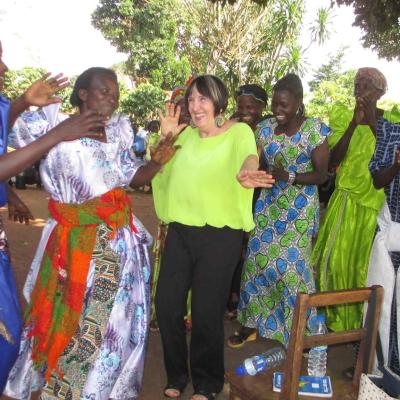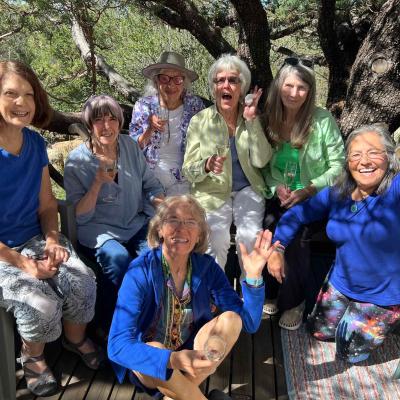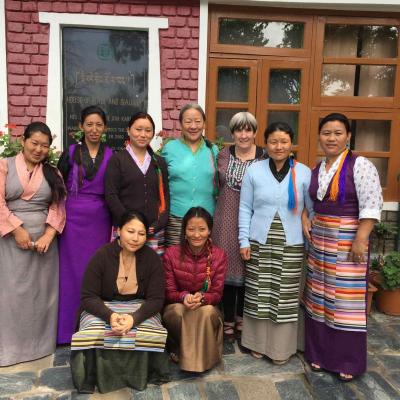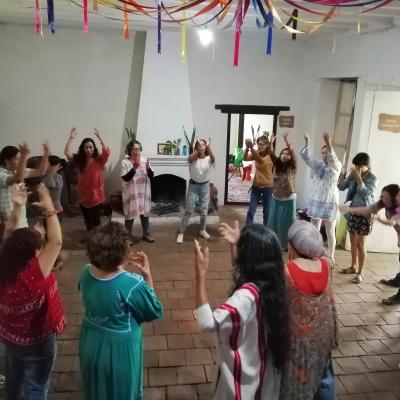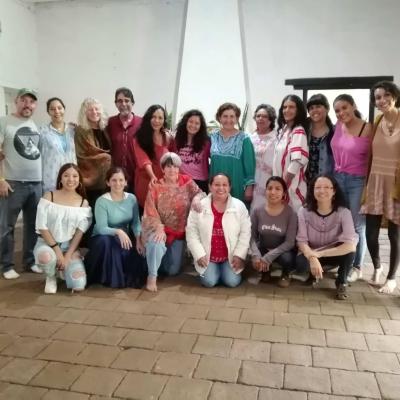Unpublished paper
Mythological messages from the body-mind
© 1998 by Sharon G. Mijares, Ph.D.
Author of Modern Psychology and Ancient Wisdom Revised Edtion (Routledge 2016)
Do we hear the stories rising from the cellular structures within our bodies? So often we limit consciousness to our cerebral hemispheres and fail to hear the narratives whispering, or perhaps shouting, within the consciousness of our tissues and organs. We have given a lot of attention to the brain and very little to the body. Carl Jung (1969) theorized that a neural substrate could contain a form of archetypal consciousness.
The ability to hear and feel the sub-personalities, fragmented self parts and archetypal forces related with life narratives is greatly enhanced by breathing practices. Breath therapies help to release the tension stored in our muscular structures. They have a powerful effect upon the psychophysiology of the breather as they stimulate the neural system. The breather then begins to experience increased energy moving through the blocks and character armoring as neural winds begin to blow.
Eastern and Middle-Eastern spiritual disciplines have utilized the breath as a healing process for over 3,000 years (Joshi, 1977, Mijares, 1991, Mueller, 1962). Only recently have Westerners discovered its ability to awaken spiritual potentials, release repressed memories and related feelings, and to heal stress and trauma. Stanislav Grof, M.D., developed holotropic therapy as a means for accessing non-ordinary states of consciousness (1988). The rebirthing movement centered upon healing birth traumas. Deep breathing brings us to fuller life.
The Sufi poet Rumi alluded to the magical power of the breath to awaken our awareness of archetypal presences within the body. This message is found in his poem, "A Goal Kneels,"
The inner being of a human being is a jungle.
Sometimes wolves dominate,
sometimes wild hogs.
Be wary when you breathe!
At one moment gentle generous qualities,
like Josephs, pass from one nature to another.
The next moment vicious qualities move in hidden ways;
Wisdom slips for a while into an ox!
A restless, recalcitrant horse suddenly
becomes obedient and smooth-gaited.
A bear begins to dance.
A goal kneels!
Human consciousness goes into a dog,
and that dog becomes a shepherd, or a hunter.
In the Cave of the Seven Sleepers
even the dogs were seekers.
At every moment a new species rises in the chest
now a demon, now an angel, now a wild animal.
There are also those in this amazing jungle
who can absorb you into their own surrender.
If you have to stalk and steal something,
steal from them! (Barks, 1990)
The poem suggests that mythological, archetypal narratives are woven into the fabric of the body. Our center of attention is focused from lofty cerebral watchtowers and we fail to hear and feel these narratives and mythological fragments whispering within the neural pathways of our beings. Our breath is held, our sensitivities dimmed and fixated by limited attention. The body is alive with archetypical stories waiting to be acknowledged. Archetypes are psychic structures containing biologically related patterns of behaviors consisting of certain qualities and expressions of being. They are related to the instinctive life forces motivating the world's mythological stories (Mijares, 1997).
Wilhelm Reich, M.D., the early founder of somatic psychologically specifically used the breath to free state-bound life energy and to invoke emotional release and healing. Reich determined this repressed energy flow to be part of humanity's armor and believed that this repression was passed on from generation to generation. He utilized the ability of the breath to enable the human musculature to relax its binding grip. Reich hypothesized that many, if not all, of our neuroses were evidenced in the inability to breathe deeply in and out in one breath (1948). The term "energy block" manifested from this work. But what is contained within an energy block and why did the Sufi poet and mystic Rumi caution to,"Be wary when you breathe"?
What happens when the breath is focused and begins to move through the neural networks and channels of the body-mind? Neural winds are increased. They stimulate cellular memories, primal, instinctual energies and awaken the body-mind from its unconscious slumber (Thurman, 1994; Washburn, 1994). Memory is inherent within the genes and cellular structures of DNA. This memory contains the stories of our genetic ancestors and those of the collective unconscious. These memories also contain dramas depicting human pathos. They are teeming with narratives of destruction, power and beauty. Repressed feelings, memories, ego-states, sub-personalities and archetypal forces can be hidden in energy blocks.
Jung was a pioneer in researching the value of these psychological constituents motivating consciousness. He believed there were both personal and collective (universal) attributes within the psyche (Jacobe, 1959). Jung described what he called the "collective unconscious" and said that it is motivated by instinctive primordial, universal mythological presences. He called these unconscious motivating forces, "archetypes." Archetypes exist preconsciously. They are psychic structures containing biologically related patterns of behaviors consisting of certain qualities and expressions of being. They are related to the instinctive life forces motivating the world's mythological stories.
Jung defined both complex and archetype. He believed that every molecule participated in the feeling and memory of a complex. His described mother, father, inferiority and power complexes. He also believed that a complex contained a primal meaning, going beyond the personal will and unconscious, connecting one with the archetypal realms of the collective unconscious (Jacobi, 1959). Jacobi writes that complexes contain an inherent ability to carry on an autonomous, unconsciously motivating existence and that "complexes are not only impressive indicators of the 'divisibility' or 'dissociability' of the psyche but also of the relative independence of the fragments, which may amount to complete psychic disintegration in all its variants." She continues by affirming that, "This fact, which is a primordial experience of mankind, is the basis of the view, widespread particularly among primitive peoples, that several souls can coexist in one and the same person" (Jacobi, p.12).
Jung also acknowledged the superiority of "affect" as being the bridge to integration and healing of dissociative disorders. He noted that "a purely intellectual insight is not enough, because one knows only the words and not the substance of the thing from inside" (in Jacobi, p. 14). In other words, insight and cognitive perception on their own are inadequate healers, as affect and body are intimately related. We never experience an emotion without an accompanying sensation.
In his article Jungian views of the body-mind relationship, (1974), Michael Fordham elaborates on psychoanalytical concerns on the relationship of psyche and soma. Even though Jung never provided evidence to affirm this, he believed that "some kinds of psychic energy are more related to the body than others, and even to different parts of the body" (Fordham, 1974, p. 169). For an example, Fordham relates Leopold Stein's assertion that
- defenses against what is not-self [introjects] are essential to health...the self carries out defense systems on a much more basic level...structures designed to receive and implement messages directed towards the preservation of the identity of self...The structures are archetypes...genes, enzymes, catalysts or pheromones...the archetypes are analogous to antibodies; an element of disorderly function in the messages is found within the self and the DNA itself (Stein, 1967, in Fordham, 1974, p. 174).
This intuitive gleaning actually preceded the scientific findings being presented by psychoneuro-immunologists and the discovery of the presence of messenger molecules, the neurotransmitters.
Do unconscious entities such as archetypal energies, sub-personalities introjects and ego-states have a specific brain location or are they manifesting through the cells, molecules and neural pathways of the body-mind (Mijares, 1995, 1997)? Is it possible that the body holds the memory of individual and collective neglect and abuse? Memory is inherent within the DNA, genes and cellular structure of the body-mind. The body's memory becomes activated as neural winds and consciousness stream through the neural networks. The traumatized psychic elements residing in cellular blocks and non-integrating neural circuits within the body emerge in the night to give voice to their experiences through the vehicles of our dreams, fantasies and regressions.
Jungian analyst Robert Stein, discusses a client who is experiencing a "regressive infantile seizure." The client is somatically gripped by this archetypal force despite his intelligence and mature awareness. In his contemplation, Stein comes to his conclusion that "if we lift the veil of our rational analytical bias, we may catch a glimpse of the offended deity who has become incarnate in the pain and anger of the psycho-somatic process." Stein then asks, "What transgression has caused the painful agony of this greater power to overwhelm him? What offerings or what sacrifice must he make so that harmony, order and wholeness can be re-established?" (1976, p. 74).
Stein explains that his client was caught up in performance-oriented social and mental activities, denying the needs of feelings and body. Until he submits and allows this balance, opposing powers will continue their war within his body-mind. This neglect manifests in individual somatic complaints, mental disturbances and illness. Culturally it manifests in substance abuse, violence and depression. These symptoms are manifestations from the neglected self.
Jung's explorations into the unconscious were indicative of his own embarkation on the hero's healing journey (Groesbeck, 1989; Jung, 1963). At the outbreak of World War he realized that he "had to try to understand what had happened and to what extent [his] own experience coincided with that of mankind in general. Therefore [his] first obligation was to probe the depths of [his] own psyche" (1963, p. 176). Archetypal forces began to flood his consciousness as Jung allowed the control of the ego-mind to relax its' binding grip. He began experiencing a steady stream of fantasies which he could not control. He realized he needed to understand these manifestations forcing themselves upon him. In describing his experience he wrote that he "stood helpless before an alien world; everything in it seemed difficult and incomprehensible. I was living in a constant state of tension...But there was a demonic strength in me, and from the beginning there was no doubt in my mind that I must find the meaning of what I was experiencing in these fantasies" (pp. 176-177).
Jung found himself experiencing intense psychic assaults as he entered unconscious realms and the onslaught began, but he stuck by his unswerving conviction that he was following a calling. He instinctively knew he had a task to fulfill. During this period Jung used yogic exercises to help subdue the intensity of emotional flooding. In this journey he personally experienced the powerful forces of the anima, animus, divine child, warriors, demons and sages that are an inherent part of humanity's consciousness. These powerful forces are also easily accessed in dissociative states. As Jung utilized the inherent power of Eastern yogic exercises based upon breath and physical movement he was further invoking the unconscious realms within the body.
In his text World religions: From ancient history to the present (1971) Geoffrey Parrinder describes how ancient Greek mythologies referenced a splitting between male and female, mind and body. The myths described the marriage of Sky and Earth. Their union safeguarded fertility. Next the cosmologies described the forcing apart of Sky and Earth. They were no longer united in sexual union. Parrinder notes that this was the beginning of rationalization. Attention was to be withdrawn into the cerebral watchtower and for the most part the soul nature dropped into the unconscious body-mind. Jung was working to heal this split.
Eastern spiritual traditions use the breath to reunite mind and body (Mijares, 2002). Mythological narratives are often initiated by breathing practices. Cells begin to quiver, muscles quake and messenger molecules travel through the neural circuitry of the body. The breathwork stimulates the body's innate intelligence as messenger molecules activate nodal points in the neural information system of body consciousness. The egoic self in its cerebral control tower is forced into acknowledging its limitations and recognizes there is more to consciousness than itself. The first indications of a deep narrative structure can manifest in a dream intimating that neglected self-parts and archetypal forces are hidden in cellular blocks, darkened shadows and power centers within the fibers of the body (Mijares, 1995). This begins what Joseph Campbell (1949) referred to as "the call," the individual awakens to the hero's journey.
We have developed a strong cognitive sense of self as a survival skill. This ego-state can reason out, understand or rationalize almost any person or circumstance. Many people have traumatic experiences in their younger years. When the young ego is unable to cope or handle the intense emotions, it disappears as another egoic personality is created. In other words younger ego-state(s) split off and are contained, isolated in their own cellular space. Soul retrieval, a term often used in shamanic healing, is about recapturing the isolated memory and its dynamic expression and feeling. During the awakening of the body-mind, the cerebral and feeling selves become cognizant of each other. But soon another stage in the heroic journey emerges as "the obstacle" surfaces. This experience is spoken of as a dragon at the gate or similar metaphors. Soul retrieval is challenged by an archetypal, wrathful force at the gate to the hiding place of the treasure.
These strange manifestations are familiar expressions of healing and emergence processes recognized by spiritual teachers of Eastern and Sufi orientations and also by depth psychotherapists using trance processes. For examples, Psychologist, author and international lecturer Stephen Gilligan writes about the break between the egoic cognitive self in the head and the archetypal, feeling self(ves) in the body in his book, Courage to love: A Self-Relations approach to psychotherapy (1997). His Self-Relations psychotherapy is focused upon healing the split in the relational field (between head and body). Sufi teacher, author and international lecturer Saadi Neil Douglas-Klotz recommends Middle-Eastern breath and mantric sound practices to enhance awareness of the depths of the self(ves) in the belly (1995). In Sufism the subconscious self(ves) is called the nafs. This sacred knowledge manifests in both Middle-Eastern and Eastern teachings.
In one of his lectures on Tibetan Buddhism titled "The descent to heaven," Joseph Campbell illustrated Tibetan teachings on enlightenment, including blissful and wrathful deities within body consciousness. As noted earlier Carl Jung theorized that a neural substrate could contain a form of archetypal consciousness (1969). The body is alive with sub-personalities and archetypal powers.
It appears that "soul retrieval" is a process of embodiment, a work of healing the immense split between the cognitive egoic self in the head and the beings manifesting in the body. In guided trance and breath therapy, a somatic sensation is often found to be associated with a very young child making sounds to him/herself. This child self is alone in a memory world of its own, hiding in non-integrating neural circuits within the body. Her (or his) story and images are unavailable to higher cerebral processes; they are locked in the limbic system of the body-mind. Perhaps muscular locks in the neck keep these hidden stories from flowing into the amygdala, the processor of emotional memory. The dragon at the gate between the body mind and the cerebral self quickly responds to block the event. This experience equates to what is called soul retrieval work. Shamans go on magical journeys to hidden places in other realms to retrieve child parts.
In my personal experience and those of my clients, I find that this fragmented child part to be hidden within the body and that often a dragon-like presence or feeling state blocks the path. Often the individual will actually growl when these levels of consciousness are evoked. Perhaps this archetypal reptilian manifestation emerges from the instinctual consciousness associated with the hind-brain, limbic and the somatic sensory system. But--going beyond its fight-flight motivations moves one from fear to the power needed for healing.
Scientists are beginning to discover that the body-mind is a tapestry woven with rich communication systems. Research scientists Gerson, Kirchgessner and Wade (1994) describe a "highly complicated independent nervous system that influences the activity, of not only the bowel, but of the organs as well". They call this the enteric nervous system, a brain in the gut. This system sends and receives messages, just as the brain in the head does. It has many of the same messenger molecules. The enteric nervous system can produce endorphins giving feelings of well-being. Is this an indication of a shift in the direction that scientists had previously imparted and will academic textbooks be changed to acknowledge the inherent intelligence of the body? Perhaps it is time to make a shift from the locus of awareness and control being solely in our heads to one that includes being centered in our bodies. Martial artists and shamans have always known that their arts are dependent upon being centered in the belly, often referred to as the "power center.".
It's well documented that cellular structures and muscular armoring hold repressed emotions within the body-mind. Emotions and associated memories are often released through body and breath therapies as they relax the chronic muscular contraction. But the narratives arising from these releases are often confining; in other words the stories we make up about what these memories, feelings and images mean. They are usually based upon pathological views of psychospiritual experience. The individual becomes a victim or a survivor recovering from trauma. These life stories are limited and the characters are often frozen in the drama. In this experience the introjected perpetrator continues to abuse negative self-narratives and self-sabotaging behaviors. This is a practical example of the archetypal dragon at the gate. Recovery of the authentic nature is the healer for this state. A human being is much more than a traumatic event. A new narrative needs to be written which includes psyche and soma (soul and body) while acknowledging the pathos of the human experience as a heroic journey leading to the emergence of authenticity of self. The late mythologist Joseph Campbell said "The passage of the mythological hero...is inward--into depths where obscure resistances are overcome, and long lost, forgotten powers are revivified..." (1949, p. 29). The world's legends, folk tales and mythological stories describe various stages of the hero/heroine's journey. He writes that "Each of these bibliographies exhibits the variously rationalized theme of the infant exile and return" (p. 323).
In mythological legends and fairy tales there are themes of dragons and demons guarding the entrances to caves or castles wherein reside hidden treasures, babies or young maidens. In dissociative disorders resulting from traumatic experiences the introjected perpetrator acts to conceal the knowledge that a violation has occurred. This inner saboteur contains both real and distorted archetypal power. It works to delude its victim, thereby blocking the way to the authentic expression of self. Even if trauma didn't occur in our childhood, the unconscious body-mind contains introjected repressive influences from family, friends, school experiences along with limiting social and religious ideologies.
In The hero with a thousand faces, Joseph Campbell wrote that,
The unconscious sends all sorts of vapors, odd beings, terrors, and deluding images up into the mind--whether in dream, broad daylight or insanity; for the human kingdom, beneath the floor of the comparatively neat little dwelling that we call our consciousness, goes down into unsuspected Aladdin caves. There not only jewels but also dangerous jinn [Arabic word for etheric spirits] abide: the inconvenient or resisted psychological powers that we have not thought or dared to integrate into our lives. And they may remain unsuspected, or, on the other hand, some chance word, the smell of a landscape, the taste of a cup of tea, or the glance of an eye may touch a magic spring, and then dangerous messengers begin to appear in the brain. These are dangerous because they threaten the fabric of the security into which we have built ourselves and our family. But they are fiendishly fascinating too, for they carry keys that open the whole realm of the desired and feared adventure of the discovery of the self. Destruction of the world that we have built and in which we live, and of ourselves within it; but then a wonderful reconstruction of the bolder, cleaner, more spacious, and fully human life--that is the lure, the promise and terror, of these disturbing night visitants from the mythological realm that we carry within (p. 8).
The mind-body separation has reflected a loss of soul. The resulting disrespect and dissociative behaviors are evidenced in addictions, sexual abuse and violence. Even our environment, the earth body, has been neglected as evidenced by the pollution of water, earth and air. Deep healing can result on an individual and planetary level as we integrate and harmonize our mind, feelings and somatic expression.
Rumi warns "be wary when you breathe" for the journey to authenticity can be a treacherous one. We have to face unwanted feelings and associated memories. We have to enter the unknown. Archetypal forces of the collective unconscious are present both enabling and preventing the retrieval of authenticity and realization of our divine nature.
The world's mythologies offer evidence that there is a collective unconscious and that archetypal forces manifest through the genetic structure, are housed in our organs, and move through the cellular pathways within our bodies. Joseph Campbell found a common strain in the world's mythologies concerning the heroic journey. This stage, called the "Return," speaks of the hero's return and treasures shared with the community. Healing can occur individually and collectively as we begin to honor these mythological narratives manifesting from within the embodied mind and heal the split between heaven and earth.
* * *
Body mind worker Charlie Badenhop teams with Coach Cindy Franklin. For more information go to,
Seishindo.org: Charlie Badenhop and Cindy Franklin's Personal Development Workshops. Workshops for coaches, trainers, consultants, and leaders."
References
Barks, C. (translater). (1990). Delicious laughter: Rambunctious teaching stories from the Mathnawi. Barnesville, GA: Maypop books.
Campbell, J. (1949). The hero with a thousand faces. Princeton, New Jersey: Princeton University Press.
Douglas-Klotz, N. (1995). Desert Wisdom. San Francisco: HarperCollins.
Gerson, M.D.; Kirchgessner, A.L; & Wade, P.R. (1994). Functional anatomy of the enteric nervous system. In Leonard R. Johnson (Ed.), Physiology of the gastrointestinal tract, (pp. 381-422). (3rd ed). New York: Raven Press.
Gilligan, S. G. (1997). The courage to love: A self-relations approach to psychotherapy. Norton.
Groesbeck, C. J. (1989, July). C.G. Jung and the shaman's vision. Journal of analytical psychology, 34,(3), 255-275.
Grof, S. (1988). The adventure of self-discovery. Albany: State University of New York Press.
Fadiman, J. & Frager, R. (1984). Personality and personal growth. (3rd ed.). New York: Harper and Row.
Fordham, M. (1974, Spring). Jungian views of the body-mind relationship. Spring. 166-178.
Jacobi, J. (1959). Complex archetype symbol in the psychology of C.G. Jung. Princeton, NJ: Princeton University Press.
Joshi, K. S. (1977). Pranayama: The science of yogic breathing. Delhi: Chaukhambla Orientalia.
Jung, C. J. (1960). On the nature of the psyche. Princeton, NJ: Bollingen Series, Princeton University Press.
Jung, C. J. (1963). Dreams, memories and reflections. London: Collins & Routledge).
Jung, C. J. (1964). Man and his symbols. New York: Doubleday & Co., Inc.
Jung, C. J. (1969). On the nature of the psyche. The collected works of C.G. Jung, Vol. 8. Princeton: Bollingen series.
Mijares, S. (Winter 2002). Modern Psychology and Ancient Wisdom: Psychological Healing Practices from the World's Religious Traditions. (Editor/Co-Author). NY: Haworth Press, Inc.
Mijares, S. (Winter, 1997). Narratives and neural winds. In Somatics: Journal of mind-body arts and sciences. Novato, CA.
Mijares, S. (1995). Fragmented self, archetypal forces and the embodied mind. Dissertation Abstracts International, 56(11),B. (University Microfilms No. 9608330)
Mijares, S. (1991). The healing power of the breath. Unpublished master's thesis, Sonoma State University, Rohnert Park, CA.
Mueller, M. F. (Trans.). (1962). The Upanisads. (Part I, Part II). New York: Dover Publications, Inc.
Parrinder, G. (Ed). (1971). World religions: From ancient history to the present. New York: Facts on File Publications.
Reich, W. (1948). The function of the organism. New York: Simon & Schuster.
Stein, L. (1967). Introducing not-self. Journal of analytical psychology, 12,(2).
Stein, R. M. (1976, Spring). Body and psyche: An archetypal view of psychosomatic phenomena. Spring. 66-80.
Thurman, R. (1994). The Tibetan book of the dead. New York: Bantam Books.
Washburn, M. (1994). Transpersonal psychology in psychoanalytic perspective. Albany: State University of New York Press.

